The Great Migration, often described as one of nature’s most spectacular events, involves the movement of millions of wildebeest, zebra, and gazelle across the Serengeti-Mara ecosystem. This annual pilgrimage, driven by primal instincts for survival and reproduction, offers a unique spectacle that draws visitors from around the globe. This guide will explore the best places and times of year for tourists to witness this breathtaking natural phenomenon.
Table of Contents
Understanding the Great Migration
Before diving into the best viewing spots, it’s crucial to understand the cyclical pattern of the migration. The journey is primarily dictated by the rains and the growth of new grass, creating a roughly circular route between the Serengeti National Park in Tanzania and the Maasai Mara National Reserve in Kenya.
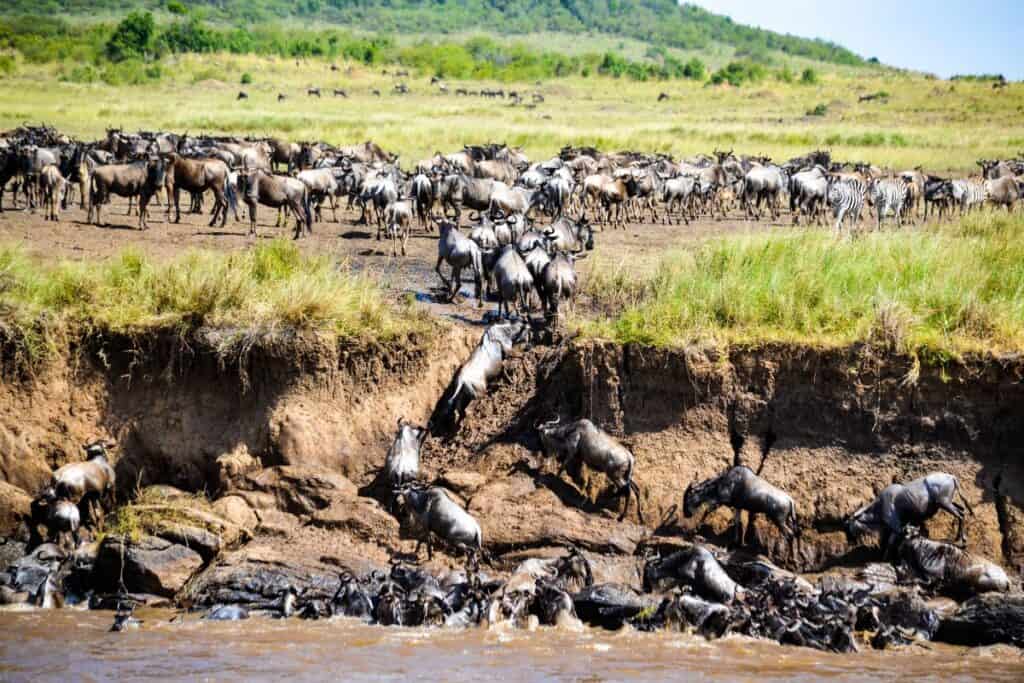
January to March: Calving Season in the Southern Serengeti
The year begins in the southern reaches of the Serengeti, where the vast plains become the birthing grounds for new calves. Between January and March, approximately 500,000 calves are born within a few weeks of each other, a strategy that overwhelms predators and ensures a higher survival rate.
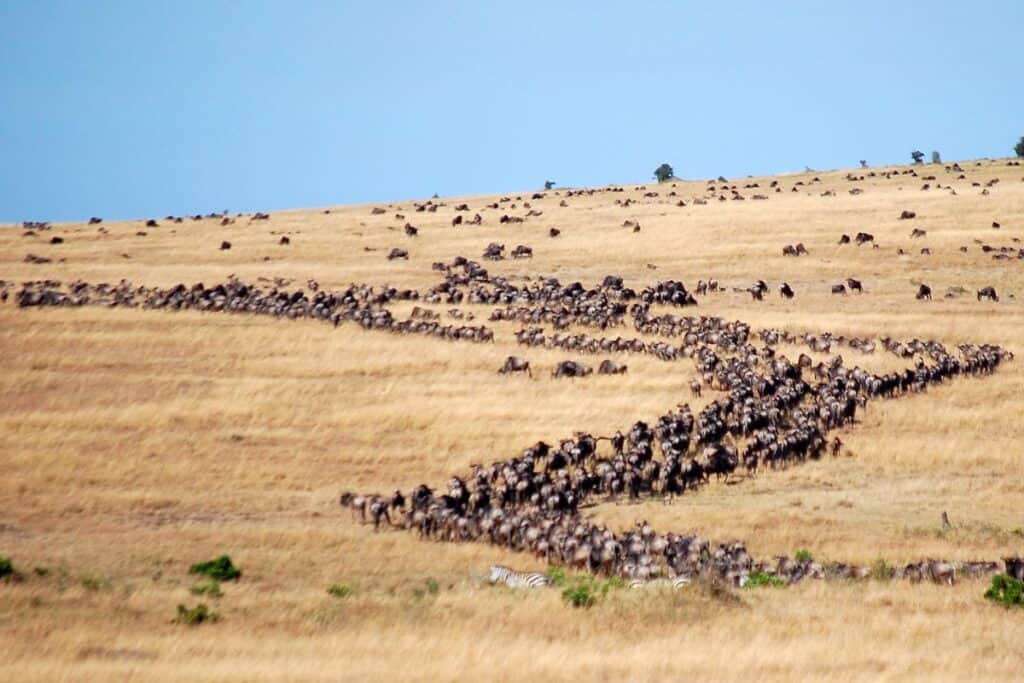
Top Spot: Ndutu Area The Ndutu region, straddling the Ngorongoro Conservation Area and the Serengeti, offers the best views of the calving season. The area’s open plains make it easy to witness births and the dramatic predator-prey interactions that follow.
April to June: The Western Corridor
As the rains end in May, the herds begin moving northwards to the fresher pastures of the Serengeti’s western corridor and towards the Grumeti River. This period is less predictable but can provide spectacular sightings of large herds gathering along the crocodile-infested waters of the Grumeti.
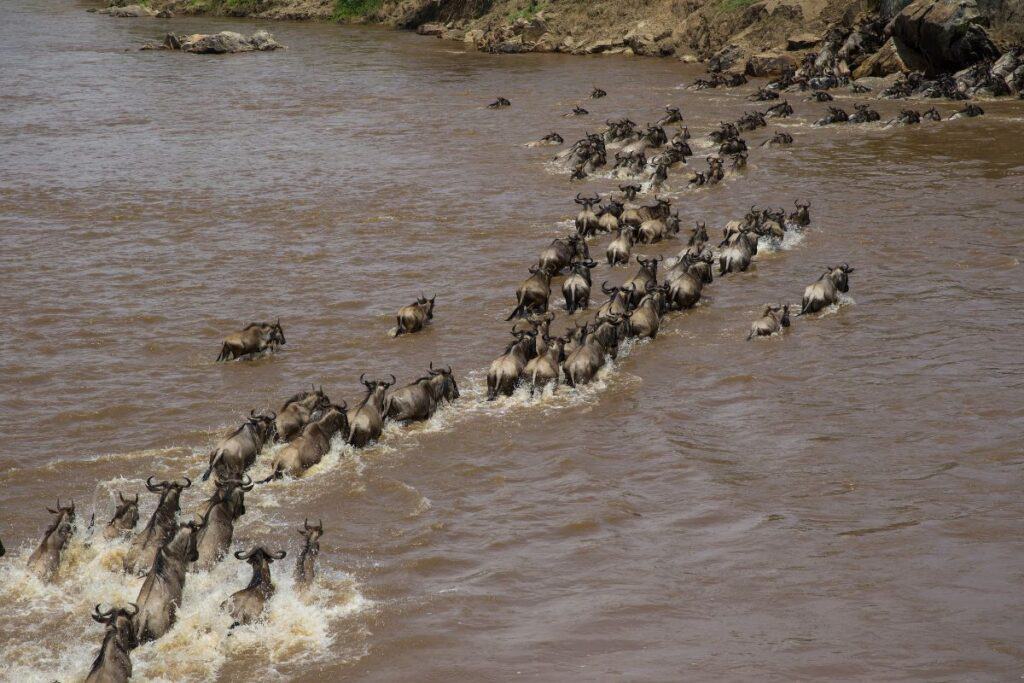
Top Spot: Grumeti River Staying in one of the riverside camps provides a front-row seat to dramatic river crossings. The perilous journey across the Grumeti is best viewed in late May or early June, where you can witness nature’s raw play of survival.
July to September: The Maasai Mara
By July, the herds reach the northernmost point of their journey, crossing into Kenya’s Maasai Mara. This is perhaps the most iconic phase of the migration, featuring dramatic river crossings over the Mara River, fraught with danger from swift currents and lurking crocodiles.
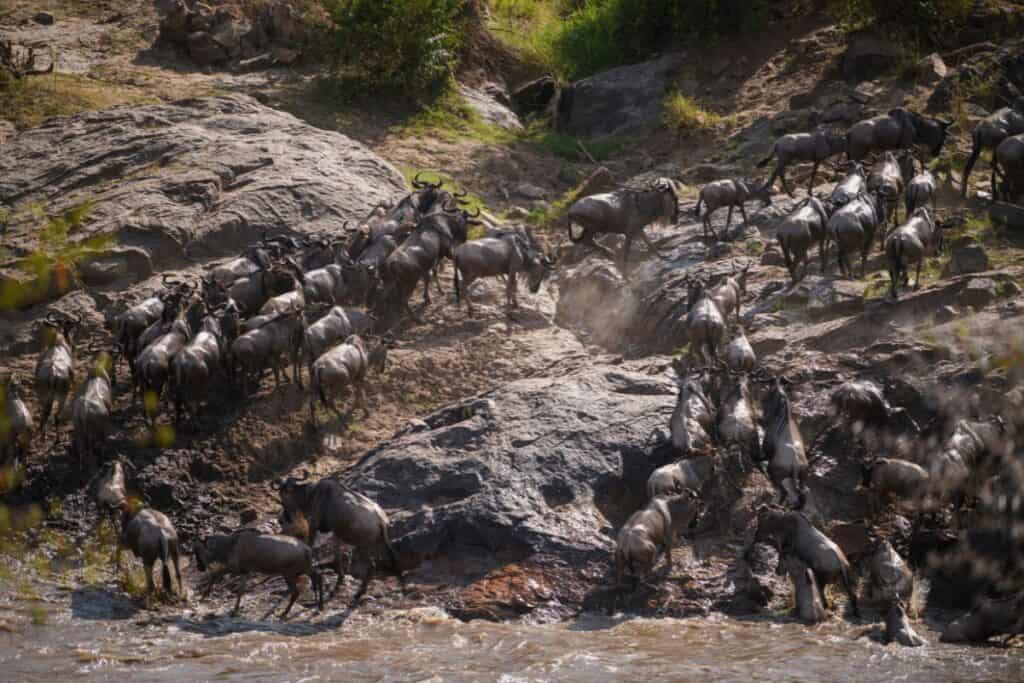
Top Spot: Mara River Choosing a camp along the Mara River gives you the best chance to see the famous river crossings. July to September is the ideal time, and the higher vantage points from some camps provide breathtaking views of the struggle for survival that defines the migration.
October to December: Returning South
As the short rains begin in late October or November, the herds start their journey back towards the Serengeti, moving through the eastern and southern parts of the Mara before heading to the now lush plains of the southern Serengeti, completing their annual cycle.
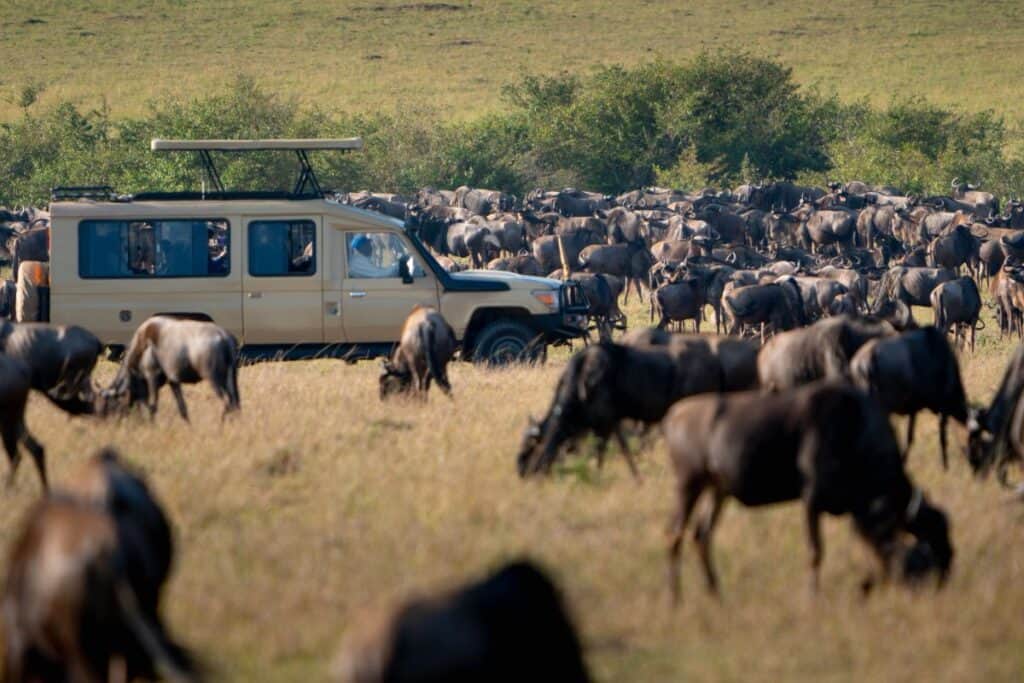
Top Spot: Lobo Area In the north-eastern part of the Serengeti, the Lobo area is excellent for viewing the herds as they make their way back to their birthing grounds. The elevated terrains offer panoramic views of the migrating herds.
cological Importance of the Great Migration
Understanding the ecological impact of the migration is crucial for appreciating its significance beyond the dramatic visuals. As the herds travel, they graze down the grass, fertilize the soil with their dung, and provide food for a range of predators and scavengers. This not only maintains the health of the grasslands but also ensures a balance within the ecosystem.
Enhancing Your Migration Experience
To truly appreciate the migration, consider the following additional tips:
Book Early: Accommodations in prime viewing spots can fill up quickly, especially during peak migration months. Booking well in advance ensures you get the best locations for viewing.
Consider Sustainability: Choose eco-friendly lodges and camps that contribute to the conservation of the region. Supporting local conservation efforts is crucial in ensuring that the Great Migration continues for generations to come.
Embrace Cultural Interactions: The Serengeti and Maasai Mara are not just about wildlife. They are home to the Maasai people, who have lived in harmony with this land for centuries. Many safaris offer cultural tours or talks that provide insights into the Maasai way of life, adding a rich layer to your travel experience.
Use Technology Wisely: While technology can enhance the safari experience, remember to sometimes put away the cameras and binoculars and just watch. The raw, unfiltered experiences of seeing the migration unfold in front of you can be deeply moving.
Memorable Moments Await
Every year, the Great Migration gives rise to stories of survival, renewal, and wonder. Each visitor leaves with a unique set of memories, whether it’s the heart-pounding thrill of a river crossing, the tender moments of a newborn wildebeest taking its first steps, or the serene beauty of a sunset over the African plains.

Planning Your Trip: Practical Advice
Embarking on a journey to witness the Great Migration is an adventure that requires careful planning and consideration. Here are some additional practical tips to help you prepare for your safari:
Visas and Vaccinations: Check the visa requirements for Tanzania and Kenya well in advance. Both countries might also require certain vaccinations, so consult with a travel health professional to ensure you meet all health entry requirements.
Travel Insurance: Opt for comprehensive travel insurance that covers medical emergencies, trip cancellations, and other unforeseen circumstances. The remote nature of safari destinations makes it essential to be prepared for any situation.
Packing Essentials: Pack light but be sure to include essential items such as:
- High SPF sunscreen and a wide-brimmed hat to protect against the sun.
- Binoculars for better viewing of wildlife from a distance.
- Insect repellent, particularly important during the wet seasons.
- Layers of clothing, as mornings and evenings can be cool, while afternoons are typically warm.
Currency and Expenses: While US dollars are widely accepted in major tourist areas, having local currency (Tanzanian Shillings or Kenyan Shillings) can be useful for smaller purchases or in more remote areas. Inform your bank of your travel plans to avoid any issues with card transactions.
Connectivity: While some safari lodges and camps offer Wi-Fi, it’s often limited. Embrace the disconnection as a chance to immerse yourself fully in the natural surroundings.
Tips for Tourists
- Choose the Right Time and Place: Depending on what you want to see, choose your location and time of visit carefully. Each part of the migration offers a different experience, from calving in the south to dramatic river crossings in the north.
- Work with Reputable Guides: Experienced guides can enhance your viewing experience by predicting the movements of the migration and navigating you to less crowded areas.
- Respect Wildlife and Environment: Always maintain a safe distance from the animals and adhere to park regulations to minimize impact on the ecosystem.
- Prepare for the Wild: Weather can be unpredictable, and the terrain rugged. Pack appropriately for all weather conditions and be prepared for the adventures of off-road travel.
- Be Patient: Wildlife viewing can require hours of waiting; the migration is no exception. Patience can reward you with some of the most thrilling natural spectacles on earth.

Conclusion
Witnessing the Great Migration is a once-in-a-lifetime experience that encapsulates the essence of wild Africa. By visiting these top spots and following these tips, you are likely to enjoy one of the most profound natural history experiences imaginable. Whether it’s the birthing of calves, the perilous river crossings, or the solemn journey back, the Great Migration remains one of the most profound demonstrations of nature’s wonder.
Read the The Great Migration article here.
